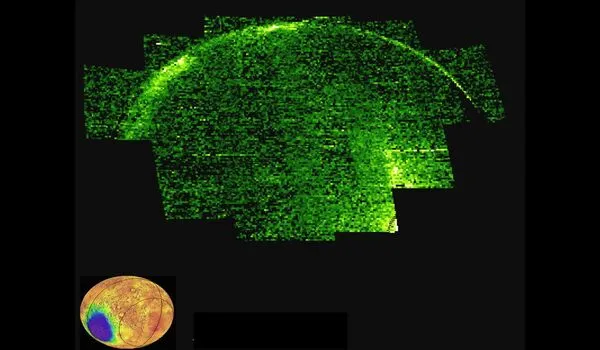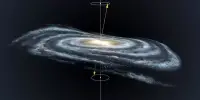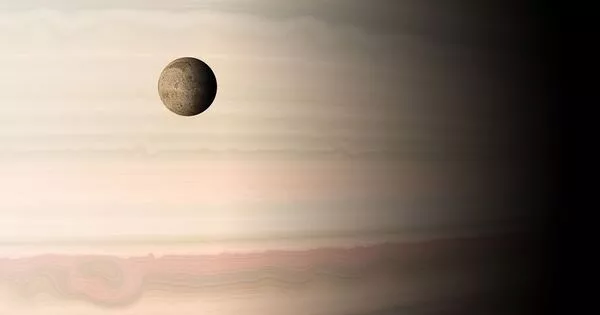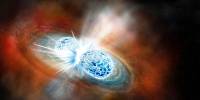An international team led by scientists from the University of Liège has discovered a glow on Mars’ night side for the first time in visible light. These new observations contribute to a better understanding of the dynamics of Mars’ upper atmosphere and its seasonal variations.
A scientific team led by researchers from the Laboratory for Planetary and Atmospheric Physics (LPAP) at the University of Liège (BE) has just observed lights in the night sky over Mars for the first time using the UVIS-NOMAD instrument on board the European Space Agency’s (ESA) Trace Gas Orbiter (TGO) satellite.
The NOMAD spectrometer suite was developed at the Royal Institute for Space Aeronomy in Uccle and tested and calibrated at the Liège Space Centre. In 2008, it was placed in a 400-kilometer-high circular Martian orbit.
UVIS-NOMAD was originally designed to map the ozone layer surrounding the planet in the ultraviolet, but it now covers a spectral range from near ultraviolet to red. The instrument is usually oriented towards the center of the planet and observes sunlight reflected by the planetary surface and atmosphere for this purpose.
Based on a proposal from our laboratory, the instrument was oriented towards the limb of the planet in order to observe its atmosphere from the edge,” explains Jean-Claude Gérard, planetologist at ULiège. Back in 2020, we were already able to detect the presence of a green emission between 40 and 150 km in altitude, present during the Martian day. This was due to the dissociation of the CO2 molecule, the main constituent of the atmosphere, by ultraviolet solar radiation.”
This emission is caused by the recombination of oxygen atoms created in the summer atmosphere and carried by the winds to the high winter latitudes. This light emission is concentrated in the polar regions to the north and south, where the oxygen atoms converge in the downward branch of the gigantic trajectory from the opposite hemisphere.
Lauriane Soret
A long journey for oxygen atoms
When the TGO satellite was observing the atmosphere at night, it discovered a new emission between 40 and 70 km altitude. “This emission is caused by the recombination of oxygen atoms created in the summer atmosphere and carried by the winds to the high winter latitudes,” explains Lauriane Soret, an LPAP researcher. When the atoms come into contact with CO2, they recombine to form an O2 molecule in an excited state that relaxes and emits visible light. “This light emission is concentrated in the polar regions to the north and south, where the oxygen atoms converge in the downward branch of the gigantic trajectory from the opposite hemisphere.” The intensity of the emission is high, in the visible range.
This process seems to be reversed every half Martian year*, and the luminosity then changes hemisphere. A similar emission was analysed on Venus by the same team using images from the Venus Express satellite. On Venus, the atoms travel from the sunlit side to the dark side where they emit the same glow as on Mars.

ULiège researchers at the forefront
These findings were made possible by LPAP researchers. They discovered the night-time emission after highlighting the presence of a layer of green light surrounding the planet during the day. The research will be carried out during the TGO mission and will provide us with valuable information about the dynamics of the Martian upper atmosphere and its variations over the course of a Martian year,” Lauriane Soret says. We discovered that UVIS detects another ultraviolet emission caused by the nitric oxide (NO) molecule in the same regions. We can refine the diagnosis and identify the processes involved by comparing the two emissions.
The NO molecule also emits light when oxygen and nitrogen atoms recombine. As with the radiation from the O2 molecule, the atoms are formed in sunlight, transported by the winds to the other hemisphere and recombine during the downward motion in the polar regions.
“These new observations are unexpected and intriguing for future trips to Mars,” says Jean-Claude Gérard. The intensity of the night glow in the polar regions is such that simple and relatively inexpensive instruments in Martian orbit could map and monitor atmospheric flows. A camera for global imaging could be carried on a future ESA mission. Furthermore, the emission is strong enough to be seen by future astronauts in orbit or from the Martian surface during the polar night’.
According to Benoit Hubert, an LPAP researcher, “remote sensing of these emissions is an excellent tool for probing the composition and dynamics of Mars’ upper atmosphere between 40 and 80 km.” This region is inaccessible to direct methods of measuring composition using satellites”.
















